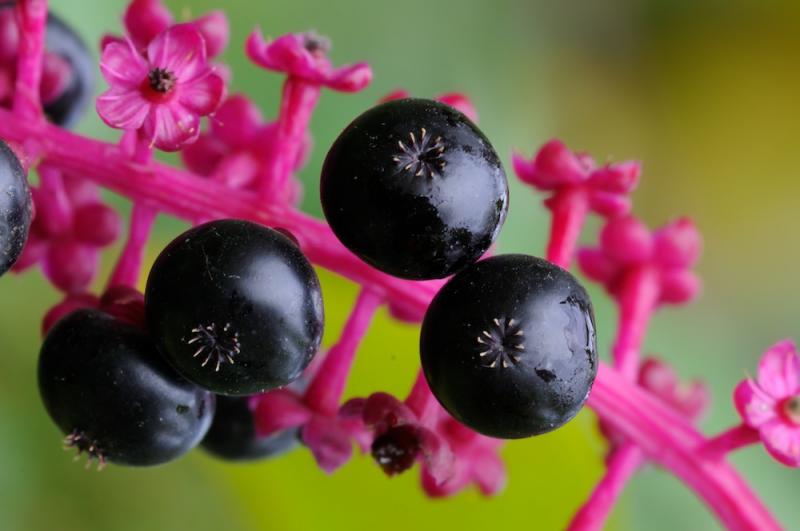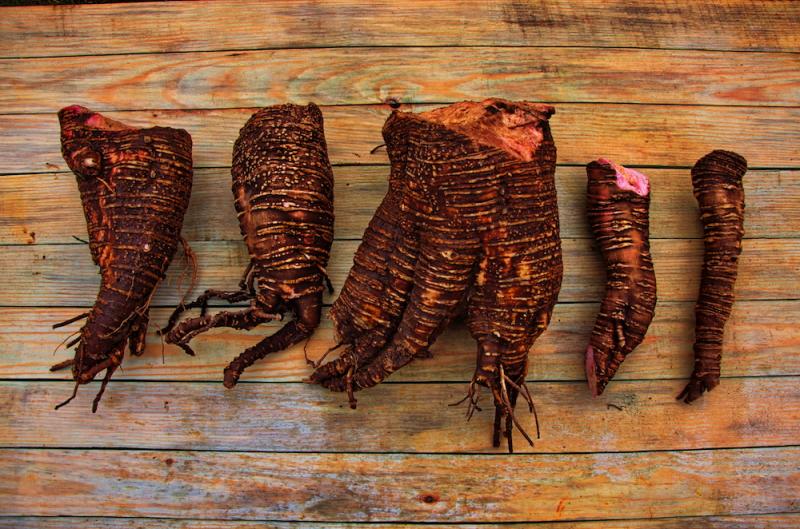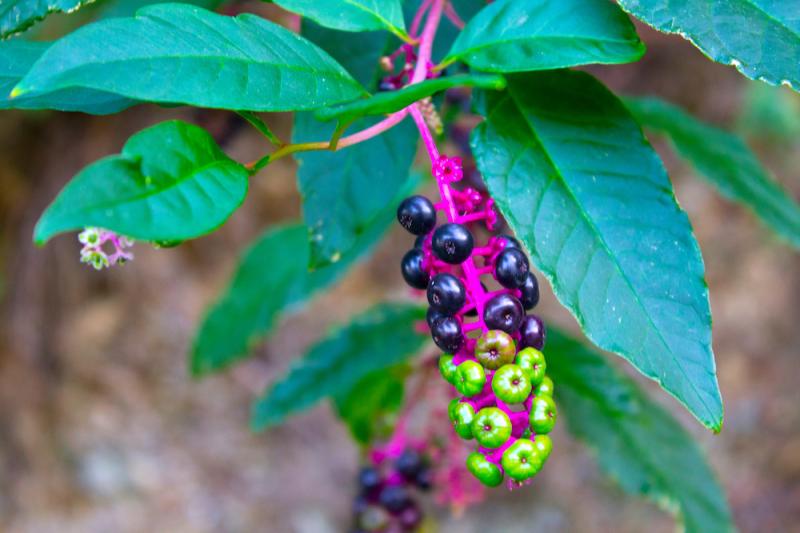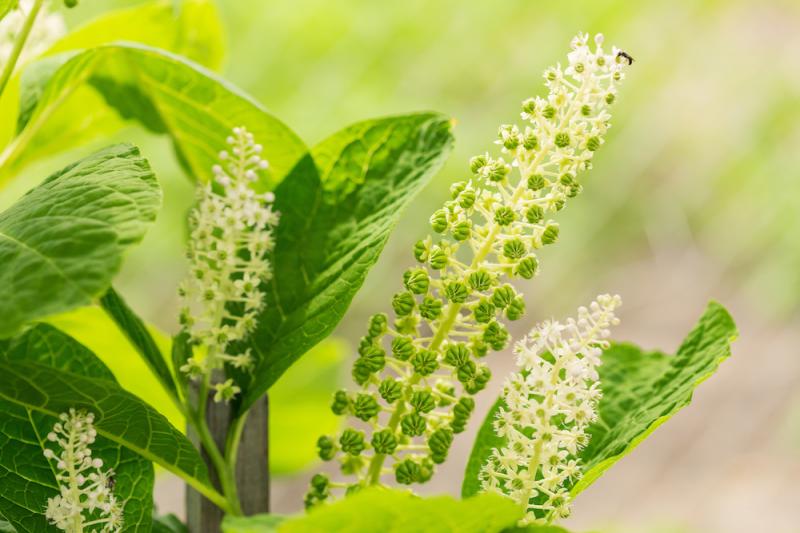
There are herbs that everyone can safely use because they have no toxicity. Some of these medicinal herbs have been eaten as foods. These include herbs like dandelion, burdock, and capsicum.
However, there are herbs that have toxic effects and can only be used safely if you know how to prepare and dose them correctly. One of these toxic herbs is poke (Phytolacca americana), typically referred to as Phytolacca among professional herbalists.
Poke Toxicity
Poke is a poisonous plant native to North America, growing primarily in the South and the Midwest. The entire plant is poisonous to humans, pets, and livestock. And while the berries are attractive, they aren't edible. Eating them has caused death in some children.
There is a short time in the early spring, the level of toxins is low enough that they can be removed by carefully boiling the young shoots and leaves in several changes of water. This has been done to make poke sallet which is considered a delicacy in the Southern states. There have been poke festivals in various states such as Kentucky, Alabama, Tennessee, Louisiana, and Mississippi.
However, the root and older leaves and shoots are poisonous and should only be used as medicine.
Safely Using Poke Medicinally
 Because of their toxicity, you should know how to prepare and dose poke berries and roots as medicine, before considering the medicinal uses.
Because of their toxicity, you should know how to prepare and dose poke berries and roots as medicine, before considering the medicinal uses.
A safe way to use poke is as an oil that is applied topically. The oil is made from fresh poke roots, which have been chopped up (wear gloves while doing this) and then slightly dried for one to three days. You then infuse the roots in oil (usually olive oil) for about six weeks and strain. The oil can also be hardened with beeswax to make a salve. Poke root oil or salve is safe for topical use, but should not be taken internally.
You can also make a tincture of the fresh roots. Tincture the fresh roots in 180-190 proof alcohol and the slightly dried roots in 100 proof alcohol. You can also find tinctures for sale on the internet. The tincture can be applied topically, like the oil. Internally, the dose is 1-5 drops diluted in ¼ to ½ cup water. Sip the water slowly once or twice daily.
When using a toxic botanical, you need to know what the signs of toxicity are. These include a burning sensation in the mouth and throat, nausea, vomiting, and diarrhea. If you start to see toxicity symptoms stop using the tincture immediately. Also do not use it if you are pregnant, nursing, or have lymphatic cancer. Poke toxicity is gradual and cumulative, so limit internal use to a period of no more than two or three weeks.
A less toxic tincture can be made from the fresh, whole berries. Place them in 80 proof alcohol and tincture them for a few weeks. For the tincture of the berries, put 1-10 drops in a small amount of water (1/8-1/4 cup) and drink the water once or twice a day. Observe the same precautions as for the root tincture.
You can also add a small amount of poke tincture to a formula, which is the only way I’ve used it internally. I add about 2-4 drops to a one-ounce bottle of an herbal formula containing milder-acting remedies. There are a few formulas in the marketplace that contain poke root as part of the formula, and you can also find people who sell the oil, salve, or tincture, too.
Poke as Lymphatic Remedy
Poke is a very potent remedy for problems involving lymphatic congestion. The oil or salve can be applied topically to swollen lymph nodes or abscesses. It works like a castor oil back to break up lumps and soften hardened tissues but is stronger acting than castor oil.
When a person has had severe lymphatic congestion, often due to chemotherapy, I’ve taken a one-ounce bottle of a formula for lymphatic congestion containing mild herbs like cleavers, red clover, burdock, and stillingia and added 3-4 drops of poke to increase its potency. This has worked very well for easing severe lymphatic congestion, swollen lymph nodes, mastitis, and other similar problems and it’s a very safe way to use the herb.
Poke as a Cancer Remedy
 Poke is a potent immune stimulant. It inhibits viral replication and stimulates both B and T lymphocytes. It also stimulates the production of interleukin 1 and tumor necrosis factor.
Poke is a potent immune stimulant. It inhibits viral replication and stimulates both B and T lymphocytes. It also stimulates the production of interleukin 1 and tumor necrosis factor.
In the past, it has been used in herbal formulas for treating cancer and other morbid conditions. It is an ingredient in Eli Jones' Compound Scrophularia and various alterative formulas.
Poke oil can be used topically to help fight cancer. It is particularly helpful for breast lumps and breast cancer but could be applied topically over any area where there is a tumor that can be felt through the skin. That’s probably the safest way to use it.
Poke has also been an ingredient in escharotic or drawing salves, such as John Christopher’s black salve or ointment. These salves are used topically for skin cancers, infected wounds, and drawing slivers. I’ve used drawing salves, but treating cancer with topical escharotic formulas can be tricky as they can produce large weeping sores and leave scars. In this modern day and age, I’d avoid using this therapy, even if it is effective, for concerns about liability. However, if modern society ever broke down, knowing how to make escharotic or drawing salves might be helpful.
Poke as a Constitutional Remedy
 A pokey person refers to someone who is large and slow, If they are also sluggish and unmotivated, they may need poke as a constitutional remedy. Matthew Wood describes this constitutional type in The Earthwise Herbal.
A pokey person refers to someone who is large and slow, If they are also sluggish and unmotivated, they may need poke as a constitutional remedy. Matthew Wood describes this constitutional type in The Earthwise Herbal.
Poke root is especially suited to large, bulky persons, with large glands, and large breasts, who are pokey – they are continually exhausted and want to fling themselves down in a chair or bed. They come home, throw their tools or clothes on the floor and lie apathetically; meanwhile their surroundings become a pigsty. Such behavior is not uncommon in teenagers, going through hormonal and glandular development, and Phytolacca [poke] is an excellent remedy for “lazy teenagers”—or “lazy teenagers of any age.”
Dorothy Hall saw Phytolacca [poke] as a remedy for people with hormonal imbalances due to a miasm, a constitutional defect due to disease or unhealthy behavior in one's ancestry. Epigenetics helps explain how this works. It’s not that genes are altered by life choices and problems, it's that the expression of those genes that can be altered, which is controlled by something called the epigenome. These altered epigenetic gene expressions can be transferred to a person's decedents.
The miasm in a person who could benefit from Phytolacca makes them prone to a disordered glandular system and rheumatic conditions. Rheumatic arthritis is an autoimmune condition and I believe that other autoimmune conditions may also be included in this picture. The pattern is aches and pains, chronically swollen lymph nodes, lethargy, and a slow personality.
Phytolacca Homeopathic
 As a constitutional remedy, I would suggest using homeopathic Phytolacca, as it would be completely safe. The homeopathic is also indicated for tendonitis or bursitis that is worse at night, pain in the breasts while nursing, and swelling of the lymph glands in the throat. I’ve also observed that some people make a flower essence from poke and indicate it is for stuck, congested energy and a lack of motivation. So, it also might be an option as a constitutional remedy.
As a constitutional remedy, I would suggest using homeopathic Phytolacca, as it would be completely safe. The homeopathic is also indicated for tendonitis or bursitis that is worse at night, pain in the breasts while nursing, and swelling of the lymph glands in the throat. I’ve also observed that some people make a flower essence from poke and indicate it is for stuck, congested energy and a lack of motivation. So, it also might be an option as a constitutional remedy.
Although it’s a little scary when you first venture into the use of toxic botanicals, I assure you that if you observe the proper cautions, you can use them with complete confidence and safety. So, if you see a situation where poke may be helpful, don’t be afraid to use it, especially topically or homeopathically.
Downloads
Steven's Articles
-

-
The Sensible Use of Caffeinated Herbs
Kola nuts, guarana, and yerba mate and other herbs…
-

-
The Health Benefits and Problems with Coffee
This popular caffeinated beverage can be beneficial…
October
-

-
Understanding Caffeine & Cellular Adaptation
Preserving the power of caffeine's buzz and the…
September
-

-
Horseradish
A pungent spice for aiding protein metabolism…
-

-
Banaba or Crepe Myrtle
A beautiful tree from Southeast Asia whose leaves…
August
-

-
Monkeyflowers
Flower essences to help see ourselves more clearly…
-

-
Mariposa Lilies
Strengthening the bond between mother and child…
-

-
The Noble Bay Leaf
A common kitchen herb for aiding digestion and…
-

-
Epimedium: Horny Goat Weed
A circulatory stimulant and kidney yang tonic…
July
-

-
The Medicinal and Nutritional Benefits of Apricots
A nutritious fruit and valuable medicinal seed for coughs
-

-
Dogwoods
Asian dogwood is used to stop excessive discharge,…
June
-

-
Neem: The Village Pharmacy
A popular Ayurvedic remedy for dental and immune…
-

-
Spilanthes: The Toothache Plant
A traditional remedy for teeth and gums, as well…
-

-
Forsythia
An anti-inflammatory, fever-reducing, and infection fighting herb
May
-

-
Buckwheat (Kashi)
A delicious, high protein, gluten-free, gut-healthy food

